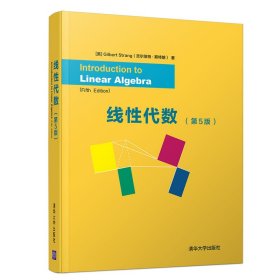
线性代数(第5版)WX
正版支持7天无理由退换货 可开票 书友可放心
¥ 75.53 7.0折 ¥ 108 全新
库存143件
江苏宿迁
认证卖家担保交易快速发货售后保障
作者[美]Gilbert Strang 吉尔伯特·斯特朗)
出版社清华大学出版社
ISBN9787302535560
出版时间2019-08
装帧平装
开本其他
定价108元
货号1201937497
上书时间2024-03-06
- 店主推荐
- 最新上架
商品详情
- 品相描述:全新
- 商品描述
-
作者简介
"作者GILBERT STRANG为Massachusetts Institute of Technology数学系教授。从UCLA博士毕业后一直在MIT任教.教授的课程有“数据分析的矩阵方法”“线性代数”“计算机科学与工程”等,出版的图书有Linear Algebra and Learning from Data (NEW)、See math.mit.edu/learningfromdata、Introduction to Linear Algebra - Fifth Edition 、Contact linearalgebrabook@gmail.com、Complete List of Books and Articles、Differential Equations and Linear Algebra。
"
目录
Table of Contents
1 Introduction to Vectors 1
1 1 VectorsandLinearCombinations 2
1 2 LengthsandDotProducts 11
1 3 Matrices 22
2 Solving Linear Equations 31
2 1 VectorsandLinearEquations 31
2 2 TheIdeaofElimination 46
2 3 EliminationUsingMatrices 58
2 4 RulesforMatrixOperations 70
2 5 InverseMatrices 83
2 6 Elimination = Factorization: A = LU 97
2 7 TransposesandPermutations 108
3 Vector Spaces and Subspaces 122
3 1 SpacesofVectors 122
3 2 The Nullspace of A: Solving Ax = 0and Rx =0 134
3 3 The Complete Solution to Ax = b 149
3 4 Independence,BasisandDimension 163
3 5 DimensionsoftheFourSubspaces 180
4 Orthogonality 193
4 1 OrthogonalityoftheFourSubspaces 193
4 2 Projections 205
4 3 LeastSquaresApproximations 218
4 4 OrthonormalBasesandGram-Schmidt 232
5 Determinants 246
5 1 ThePropertiesofDeterminants 246
5 2 PermutationsandCofactors 257
5 3 Cramer’sRule,Inverses,andVolumes 272
vii
6 Eigenvalues and Eigenvectors 287
6 1 IntroductiontoEigenvalues 287
6 2 DiagonalizingaMatrix 303
6 3 SystemsofDifferentialEquations 318
6 4 SymmetricMatrices 337
6 5 PositiveDe niteMatrices 349
7 TheSingularValueDecomposition (SVD) 363
7 1 ImageProcessingbyLinearAlgebra 363
7 2 BasesandMatricesintheSVD 370
7 3 Principal Component Analysis (PCA by the SVD) 381
7 4 TheGeometryoftheSVD 391
8 LinearTransformations 400
8 1 TheIdeaofaLinearTransformation 400
8 2 TheMatrixofaLinearTransformation 410
8 3 TheSearchforaGoodBasis 420
9 ComplexVectorsand Matrices 429
9 1 ComplexNumbers 430
9 2 HermitianandUnitaryMatrices 437
9 3 TheFastFourierTransform 444
10 Applications 451
10 1GraphsandNetworks 451
10 2MatricesinEngineering 461
10 3 Markov Matrices, Population, and Economics 473
10 4LinearProgramming 482
10 5 Fourier Series: Linear Algebra for Functions 489
10 6ComputerGraphics 495
10 7LinearAlgebraforCryptography 501
11 NumericalLinear Algebra 507
11 1GaussianEliminationinPractice 507
11 2NormsandConditionNumbers 517
11 3 IterativeMethodsandPreconditioners 523
12LinearAlgebrain Probability& Statistics 534
12 1Mean,Variance,andProbability 534
12 2 Covariance Matrices and Joint Probabilities 545
12 3 Multivariate Gaussian and Weighted Least Squares 554
MatrixFactorizations 562
Index 564
SixGreatTheorems/LinearAlgebrain aNutshell 573
内容摘要
线性代数内容包括行列式、矩阵、线性方程组与向量、矩阵的特征值与特征向量、二次型及Mathematica 软件的应用等。 每章都配有习题,书后给出了习题答案。本书在编写中力求重点突出、由浅入深、 通俗易懂,努力体现教学的适用性。本书可作为高等院校工科专业的学生的教材,也可作为其他非数学类本科专业学生的教材或教学参考书。
主编推荐
Gilbert Strang的《线性代数(第5版)》是一本经典线性代数教材。此书深入浅出地展示了线性代数的所有核心概念,讲述过程中恰当穿插了各种应用,体现了线性代数特别有用的思想。
精彩内容
Preface
I am happy for you to see this Fifth Edition of Introduction to Linear Algebra. This is the text for my video lectures on MIT’s OpenCourseWare (ocw.mit.edu and also YouTube). I hope those lectures will be useful to you (maybe even enjoyable !).
Hundreds of colleges and universities have chosen this textbook for their basic linear algebra course. A sabbatical gave me a chance to prepare two new chapters about probability and statistics and understanding data. Thousands of other improvements too— probably only noticed by the author. . . Here is a new addition for students and all readers:
Every section opens with a brief summary to explain its contents. When you read a new section, and when you revisit a section to review and organize it in your mind, those lines are a quick guide and an aid to memory.
Another big change comes on this book’s website math.mit.edu/linearalgebra. That site now contains solutions to the Problem Sets in the book. With unlimited space, this is much more .exible than printing short solutions. There are three key websites :
ocw.mit.edu Messages come from thousands of students and faculty about linear algebra on this OpenCourseWare site. The 18.06 and 18.06 SC courses include video lectures of a complete semester of classes. Those lectures offer an independent review of the whole subject based on this textbook—the professor’s time stays free and the student’s time can be 2 a.m. (The reader doesn’t have to be in a class at all.) Six million viewers around the world have seen these videos (amazing). I hope you .nd them helpful.
web.mit.edu/18.06 This site has homeworks and exams (with solutions) for the current course as it is taught, and as far back as 1996. There are also review questions, Java demos, Teaching Codes, and short essays (and the video lectures). My goal is to make this book as useful to you as possible, with all the course material we can provide.
math.mit.edu/linearalgebra This has become an active website. It now has Solutions to Exercises—with space to explain ideas. There are also new exercises from many dif-ferent sources—practice problems, development of textbook examples, codes in MATLAB and Julia and Python, plus whole collections of exams (18.06 and others) for review.
Please visit this linear algebra site. Send suggestions to linearalgebrabook@gmail.com
i
The Fifth Edition
The cover shows the Four Fundamental Subspaces—the row space and nullspace are on the left side, the column space and the nullspace of AT are on the right. It is not usual to put the central ideas of the subject on display like this! When you meet those four spaces in Chapter 3, you will understand why that picture is so central to linear algebra.
Those were named the Four Fundamental Subspaces in my .rst book, and they start from a matrix A. Each row of A is a vector in n-dimensional space. When the matrix has m rows, each column is a vector in m-dimensional space. The crucial operation in linear algebra is to take linear combinations of column vectors. This is exactly the result of a matrix-vector multiplication. Ax is a combination of the columns of A.
When we take all combinations Ax of the column vectors, we get the column space. If this space includes the vector b, we can solve the equation Ax = b.
May I call special attention to Section 1.3, where these ideas come early—with two speci.c examples. You are not expected to catch every detail of vector spaces in one day! But you will see the .rst matrices in the book, and a picture of their column spaces. There is even an inverse matrix and its connection to calculus. You will be learning the language of linear algebra in the best and most ef.cient way: by using it.
Every section of the basic course ends with a large collection of review problems. They ask you to use the ideas in that section—-the dimension of the column space, a basis for that space, the rank and inverse and determinant and eigenvalues of A. Many problems look for computations by hand on a small matrix, and they have been highly praised. The Challenge Problems go a step further, and sometimes deeper. Let me give four examples:
Section 2.1: Which row exchanges of a Sudoku matrix produce another Sudoku matrix?
Section 2.7: If P is a permutation matrix, why is some power Pk equal to I?
Section 3.4: If Ax = band Cx = bhave the same solutions for every b, does Aequal C?
Section 4.1: What conditions on the four vectors r, n, c, . allow them to be bases for the row space, the nullspace, the column space, and the left nullspace of a 2 by 2 matrix?
The Start of the Course
The equation Ax = b uses the language of linear combinations right away. The vector Ax is a combination of the columns of A. The equation is asking for a combination that producesb. The solution vector x comes at three levels and all are important:
1.
Directsolution to .nd x by forward elimination and back substitution.
2.
Matrix solutionusing the inverse matrix: x = A.1b (if Ahas an inverse).
3.
Particular solution(to Ay = b) plus nullspace solution (to Az =0).
That vector space solution x = y+ z is shown on the cover of the book.
Direct elimination is the most frequently used algorithm in scienti.c computing. The matrix Abecomes triangular—then solutions come quickly. We also see bases for the four subspaces. But don’t spend forever on practicing elimination . . . good ideas are coming.
The speed of every new supercomputer is teste
— 没有更多了 —






















以下为对购买帮助不大的评价